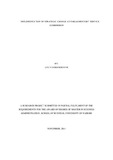| dc.description.abstract | The environment in which organizations operate in is ever changing. For survival, organizations must develop and implement various strategies geared towards survival in turbulent environments and to increase their competitiveness. In an ever-changing global economy, Johnson and Scholes (2002) notes that organizations must formulate strategies on how to tackle the challenges that come with the changes through planning and implementing the requisite change programs. Various models on change management have been developed by various scholars. They include Lewin's (1947) three- step model of change, Kanter et al (1992) model of change management, Bullock and Batten (1985) four-phase model of planned change, Kotters (1996) eight -steps change model and Senge's (1990) learning organization model.
The objectives of the study were to establish change management practises at Parliamentary Service Commission and identify factors influencing implementation of strategic change. The findings indicated that the need for change at P ARLSCOM was necessitated by the commission's quest to facilitate members of parliament fulfill their constitutional mandate of oversight, legislation, representation and resource allocation in the most efficient and effective manner.
The research was conducted through a case where, qualitative research technique for data collection was applied. Primary data was collected through personal interviews using an interview guide which was administered to members of board of management of P ARLSCOM. Secondary data was obtained from various Acts of Parliament, The Constitution of Kenya (GOK,2010), PARLSCOM Strategic Plans and various reports obtained from the library.
The data collected was summarized according to study theme being change management practices and factors influencing implementation of strategic change and analyzed using content analysis. From the findings, P ARLSCOM change management practises entailed evaluation of previous strategic plans, the constitution of Kenya (amendment) Act, No.3 of 1999, vision 2030 first medium-term plan 2008-2012 and presidential Circular No. 112008. In addition, the institution analyzed various changes in the legal framework and identified gaps which were addressed through implementation of various changes in its infrastructure, structure, systems and processes as required. The board of management under the leadership of the Clerk of the National Assembly was the guiding coalition who offered leadership and monitored the change output to ensure the commission achieved its objectives.
The researcher identified a number of factors that influenced implementation of change process. They included organization culture which did not support change process, resistance to change, organization power and politics, structure, system and constitutions of Kenya (2010). The respondents noted that leadership of the institution under the guidance of Speaker of the National assembly played a critical role in the change process which enabled the institution implement various programmes successfully. Finally, the constitution of Kenya, 2010 remains the greatest force for change in P ARLSCOM due to various provisions which require more changes to be implemented to ensure the institution fulfills its mandate of serving a bicarmel system of parliament. | en_US |

